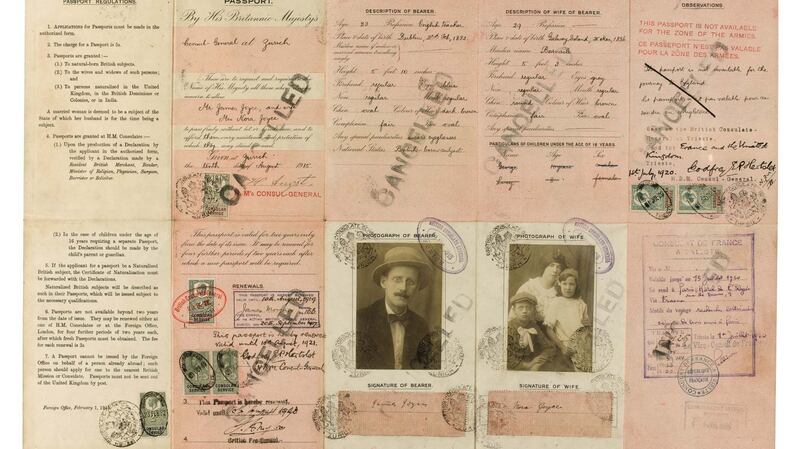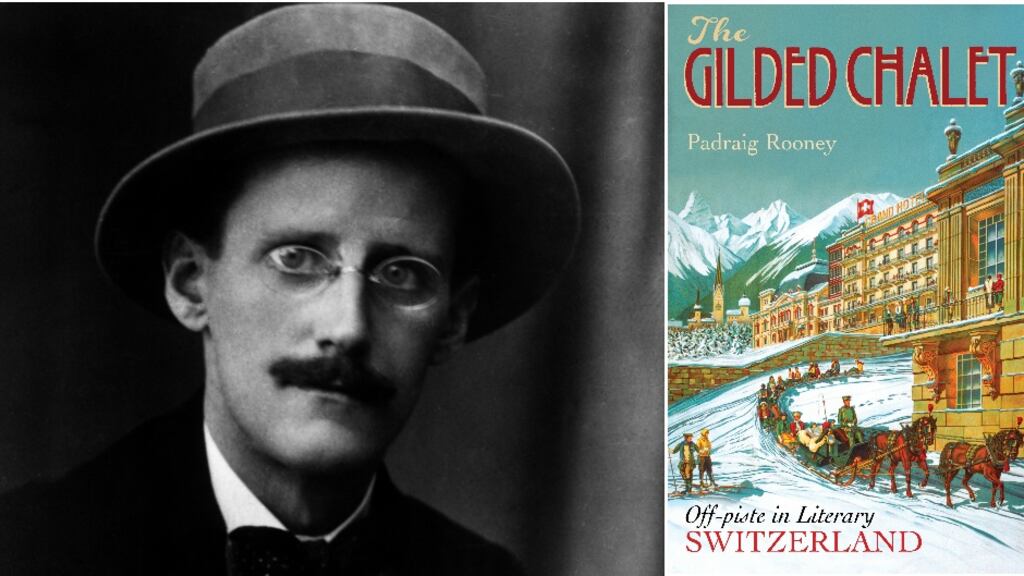Zürich during the first World War was awash with refugees and racketeers – a vibrant hodgepodge of pacifists, revolutionaries, anarchists and artists who kept the Swiss police in shoe leather. Vladimir Lenin arrived in 1916, taking a room one hundred yards from the Cabaret Voltaire where the Dada movement held noisy court. Lenin was a habitué of the Cafe Odéon and most likely rubbed shoulders there with James Joyce. The revolutionary was more firebrand about his hosts than the Irish writer:
Switzerland is the most revolutionary country in the world… There is only one slogan that you should spread quickly in Switzerland and in all other countries: armed insurrection!
The Swiss were keen to see Lenin safely across the border. In 1917 they put him on a sealed train in Zürich, which took him across Germany to the Finland Station. The rest, as they say, is history.

It was in Zürich that Joyce’s eye troubles turned serious. His glaucoma required an iridectomy, the first of 11 operations over the next 15 years. In 1917 he wrote to Ezra Pound: “On Saturday when walking in the street I got suddenly a violent Hexenschuss which incapacitated me from moving for about twenty minutes. I managed to crawl into a tram and get home. It got better in the evening but next day I had symptoms of glaucoma again – slightly better today. Tomorrow morning I am going to the Augenklinik. This climate is impossible for me so that, operated or not, I want to go away next month. I am advised to go to Italian Switzerland.”
The eye clinic operated successfully and Nora returned from Locarno to comfort her husband. In the days following, Joyce wrote one of his more touching poems about loss of youthful vision and vim, Bahnhofstrasse, named for Zürich’s main thoroughfare, the most expensive shopping street in the world. He was only 37:
Ah star of evil! star of pain!
Highhearted youth comes not again
They wintered in Locarno. Market day in Italian-speaking Locarno reminded Nora of Trieste. “It was quite lively to hear the men calling out the prices and making as much noise as they could just like in Trieste.” The manuscript title page of Ulysses bears the inscription “Pension Daheim, Locarno, Switzerland”. Nora and the children relaxed into the Swiss-Italian atmosphere, with its accents of home.
Glaucoma didn’t prevent his other eye wandering. Two women took hold of Joyce’s imagination, apart from Nora, during his stay in Switzerland. Both made their way into Ulysses, forming the composite figure of Gerty MacDowell showing her drawers to a masturbating Bloom.
Dr Gertrude Kaempffer was a 26-year-old recovering from tuberculosis in Orselina above Locarno. When she rebuffed his initial advances, Joyce conducted an erotic correspondence with her from Zürich, using a poste restante address, as Bloom does in Ulysses.
The second of Joyce’s dalliances, Marthe Fleischmann, was closer to home. Their windows were in sight of each other and he first spotted her as she was pulling the toilet chain. Joyce gives to the hero of Finnegans Wake an erotic interest in watching girls pee, and the author’s correspondence with Nora confirms this peccadillo. Marthe was attractive, had notions about herself and walked with a slight limp (as does Gerty in Ulysses). Joyce cast Marthe as the reincarnation of his youthful muse first spotted on Dublin’s North Strand: girlish, birdlike, ethereal, her skirts hiked up. He began a correspondence with her in French, deploying his usual Irish blether about Dante, Shakespeare and the Dark Lady of the Sonnets – and by the way, could we meet?
The assignation was arranged on his birthday – February 2nd, Candlemas Day. Joyce borrowed his friend Frank Budgen’s flat and lit the candles. He confided in Budgen that he had “explored the coldest and hottest parts of a woman’s body”.
Joyce made a second visit to Locarno in May 1919, in the company of Budgen. He was an ex-sailor, a painter, and had modelled for the Swiss artist August Suter as well as for the sailor on a pack of Player’s Navy Cut cigarettes.
They encountered the Baroness St Leger, who lived on the tiny Isola di Brissago on Lake Maggiore. Joyce was working on the Circe episode of Ulysses. Circe in Homer is a kind of temptress emasculator, with Odysseus as her captive toy-boy and her island as a dolce far niente. Joyce thought the Baroness might fit the bill: she had been thrice married and he dubbed her the "Siren of the Lago Maggiore".
The Baroness was born in St Petersburg in 1856 and rumoured to be the illegitimate daughter of Tsar Alexander II. Antoinetta was pretty and vivacious. Her piano teacher had been Franz Liszt. Two husbands quickly palled. Her third husband was the Anglo-Irish Lord Richard-Fleming St Leger, from Kingstown (Dún Laoghaire), thought to be descended from Richard the Lionheart. They bought the two Brissago islands for 10,000 Swiss francs and the Baroness proceeded to import thousands of plants and turned the hideaway into a botanical paradise befitting the Locarno microclimate. Her gardens are still flourishing today. By the time Joyce pitched up in 1919, she was 63, had seen off three husbands, and was as flighty as ever, coming over the water to greet him standing up in her boat.
Fritz Senn, the keeper of the flame at the James Joyce Foundation in Zürich, has uncovered numerous references to his city in Ulysses and Finnegans Wake. Mostly Zürich served as a refuge from the war and provided Joyce with an atmosphere, an urban vibe and a cacophony of friends who fuelled his masterpiece. When the Joyce family returned to Trieste in 1919, it had become a backwater. Paris was the happening place. Zürich had whetted his appetite for it.
Since 1920, Joyce, Nora and their two children had been living in Paris, where the writer had achieved fame and squandered some fortune. Now, with Paris occupied, they were on the move once more.
Joyce was almost blind in those last months of 1940. He and his family were with Maria Jolas near Vichy, where she struggled to maintain the bilingual school which she had founded. The Swiss Aliens Police rejected Joyce’s initial application for visas on the supposition that he and his family were Jews. Swiss writer Jacques Mercanton put the authorities right on this point. Joyce himself privately declared he “was not a Jew from Judea but an Aryan from Erin”. The mayor of Zürich and other notables vouched for him. Cantonal authorities wanted a guarantee of 50,000 Swiss francs, later reduced to 20,000. The Joyce family eventually succeeded in gaining permits.
In December 1940 they entered Switzerland by way of Geneva and spent the night of December 14th at the Richemonde Hotel. Sean Lester, acting Secretary-General of the League of Nations and a Belfast man, had tea with the Joyce family on the Sunday afternoon, in the marble and ormolu salon of their hotel:
“The famous Joyce is tall, slight, in the fifties, blue eyes and a good thatch of hair. No one would hesitate in looking at him to recognize his nationality and his accent as Dublin as when he left it over thirty years ago. His eyesight is very bad and he told me it had been saved some years ago for him by the famous Vogt of Zürich, who had also operated on de Valera.”
Finnegans Wake, 17 years in the writing, had received a puzzled reception the previous year. Needing two magnifying glasses to read and write, Joyce was addicted to Radio Éireann.
“They were going to settle in Zürich, where they had some good friends. I said I thought it was an unusual place for him to choose and asked, what about Suisse Romande? His wife then intervened and said that Zürich had always been associated with certain crises in their life […]: they had spent their honeymoon there; it was there that Joyce’s eyesight had been saved and now they were going back in another crisis. They liked the solid virtues of the people.”
It was those solid Swiss virtues that supported them as the world again turned to war. Joyce wrote to the Mayor of Zürich to thank him. “The connection between me and your hospitable city extends over a period of nearly forty years and in these painful times I feel honoured that I should owe my presence here in large part to the personal guaranty of Zürich’s first citizen.”
He walked out in the snow in the afternoons with grandson Stephen, to the confluence of Zürich’s two rivers, the Sihl and the Limmat. Today the spot, facing north, has an inscription from Finnegans Wake: “Yssel that the limmat?” and “legging a jig or so on the sihl”.
Joyce died in Zürich on January 13th, 1941, aged 59, and is buried next to Nora in the city’s Fluntern Cemetery, within a lion’s roar of the zoo.
Maria Jolas, Joyce and me
One evening, driving back to Switzerland, I tuned into France Musique and immediately recognised the voice of Maria Jolas, resurrected from the Paris of 1979. But it couldn’t be, could it? She would have to be a ghost, pushing 110 years of age. It turned out, however, to be her musician daughter Betsy. The resemblance between their voices was uncanny.
Born in 1893 in Kentucky, Maria Jolas accompanied James Joyce’s pure tenor singing in the nineteen-twenties and thirties, when her husband, Eugene Jolas, was publishing the Irish writer in the magazine transition. “Carry me along, Taddy, like you done through the toy fair!” Joyce writes on the last page of Finnegans Wake. In her memoirs Maria relates that it was her father that Joyce purloined, carrying her through the Jefferson County Fair in Louisville, Kentucky.
Before the first World War she had seen Gustav Mahler conduct the New York Philharmonic and heard Caruso sing at the Met. In 1913 she sailed to Bremen on the Imperator and drank hot bouillon on deck each morning of the ten-day voyage. In Berlin she studied singing and saw Frank Wedekind’s play Spring Awakening.
It was a copy of this play she gave me 65 years later in 1979, when she was well into her eighties. I was supervising the dorms of a school in Paris, so perhaps she thought I had need of Wedekind’s scurrilous awakening. Maria had founded the first Bilingual School of Paris in Neuilly in 1932. Usually around teatime I rose in the creaking lift to her apartment on rue de Rennes. I remember the sound of electric typing followed by her heavy tread on the parquet. She was protective of Joyce in his academic afterlife, but voluble nonetheless. “I used to know another Padraic, but he spelled it with a c,” she said, referring to the Irish poet Padraic Colum. Once, after a glass of sherry, she broke into the Lass of Aughrim, one of Joyce’s favourites.
The Gilded Chalet: Off-piste in Literary Switzerland by Padraig Rooney is published by Nicholas Brealey, price £20. He’ll be talking at the Gutter Bookshop in Dublin on Friday, November 27th at 6.30pm
















